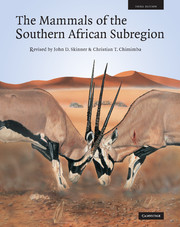Book contents
- Frontmatter
- Contents
- Editorial board
- Acknowledgements
- Foreword
- Preface
- The Mammal Research Institute
- R. H. N. Smithers
- Explanatory notes
- SUPERCOHORT AFROTHERIA
- COHORT PAENUNGULATA
- SUPERCOHORT EUARCHONTAGLIRES COHORT GLIRES
- COHORT EUARCHONTA
- SUPERCOHORT LAURASIATHERIA
- COHORT FERUNGULATA
- Bibliography
- Appendix 1 Conservation status of southern African mammals
- Appendix 2 Colloquial names
- Index of scientific names
- Index of English colloquial names
- List of subscribers
- Plate Section
- Plate Section
- Plate Section
- Plate Section
- Plate Section
- Plate Section
- Plate Section
Appendix 1 - Conservation status of southern African mammals
Published online by Cambridge University Press: 05 July 2013
- Frontmatter
- Contents
- Editorial board
- Acknowledgements
- Foreword
- Preface
- The Mammal Research Institute
- R. H. N. Smithers
- Explanatory notes
- SUPERCOHORT AFROTHERIA
- COHORT PAENUNGULATA
- SUPERCOHORT EUARCHONTAGLIRES COHORT GLIRES
- COHORT EUARCHONTA
- SUPERCOHORT LAURASIATHERIA
- COHORT FERUNGULATA
- Bibliography
- Appendix 1 Conservation status of southern African mammals
- Appendix 2 Colloquial names
- Index of scientific names
- Index of English colloquial names
- List of subscribers
- Plate Section
- Plate Section
- Plate Section
- Plate Section
- Plate Section
- Plate Section
- Plate Section
Summary
The threatened species categories now used in Red Data Books and Red Lists have been in place, with some modification, for almost 30 years. Since their introduction these categories have become widely recognised and they are now used in a whole range of publications and listings, produced by the IUCN and numerous governmental and non-governmental organisations. Red Data Books provide an easily and widely understood method for highlighting those species under higher extinction risk, in order to focus attention on conservation measures designed to protect them.
In 1984 the Species Survival Commission (SSC) of the IUCN held a symposium (Fitter & Fitter, 1987) that examined the issue of revising the categories and at which a number of options were considered for a revised system. No single proposal resulted. The current phase of development began in 1989 with a request from the SSC Steering Committee to develop a new approach that would provide the conservation community with useful information for action planning. After numerous versions of draft proposals (Mace & Lande, 1991; Mace et al., 1992; IUCN, 1993; Mace & Stuart, 1994), a final document, incorporating changes as a result of comments from IUCN members, was adopted by the IUCN Council in December 1994. The 1996 IUCN Red List of Threatened Species was the first publication to utilise these new categories of threat.
- Type
- Chapter
- Information
- The Mammals of the Southern African Sub-region , pp. 788 - 801Publisher: Cambridge University PressPrint publication year: 2005



